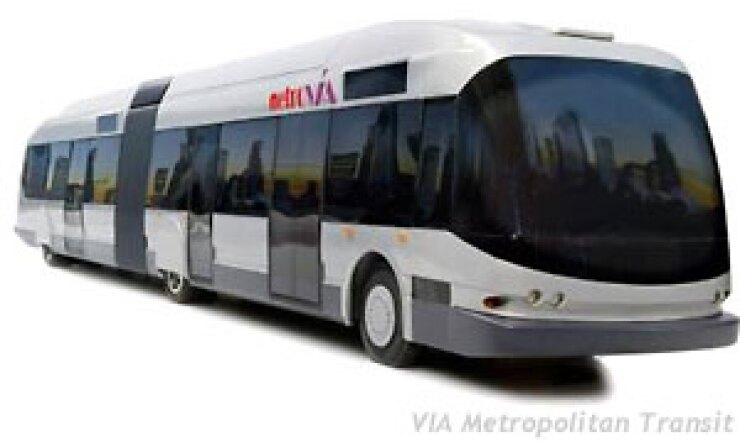
DALLAS — As Texas urban transit authorities continue to expand light-rail lines to ease congestion, they are also investing heavily in their workhorse buses, combining local and federal funds to develop cleaner, more efficient systems.
Dallas Area Rapid Transit is planning to spend $250 million to buy or lease an entire fleet of 452 buses powered by compressed natural gas. The plan could require bond issuance, but DART board has not decided on the financing details.
In San Antonio, the VIA Metropolitan Transit system is converting an historic train station into the Westside Multimodal Transit Center, which would serve a bus rapid transit, or BRT, corridor and possibly support light rail in the future.
It would also offer access to Amtrak and intercity bus service, and the site would be a station on the proposed Lone Star Rail commuter system between Austin and San Antonio.
In El Paso, the Mesa Corridor BRT project is in line to receive $13.54 million of federal funding under the Federal Transit Administration’s New Starts program.
Under a plan the El Paso City Council approved last year, the $136 million bus rapid-transit system would receive $55 million from the city and the rest in federal and state money.
“Introducing bus rapid-transit service linking downtown El Paso with the local state university campus and other important local destinations will greatly improve the flow of traffic and offer a speedier ride for commuters,” U.S. Transportation Secretary Ray LaHood said in announcing the grant.
In Austin, one of the state’s most congested cities, the Capital Metro Transit Authority is building a $47.6 million BRT system and plans to get $38.1 million of federal funding under President Obama’s recommended budget.
The Texas projects are among 10 start-ups across the country recommended for a combined $569.3 million of federal grants. Others include rail and BRT projects in Arizona, California, Colorado, Florida, Michigan, Oregon, Utah and Washington state.
An additional 11 projects that were recommended for funding in previous years, but have not received federal commitments, are being recommended for $1.4 billion in this year’s budget.
“The projects we’re recommending for funding this year have so far met the demanding requirements of the Federal Transit Administration’s New Starts program, which ensures that they represent a good investment of taxpayer dollars,” said administrator Peter Rogoff.
As other Texas cities try to catch up to DART’s rail system — the oldest and largest one in the state — the authority is preparing to reach out to Dallas-Fort Worth International Airport with an Orange Line rail extension that would tie into the Green Line that opened in December carrying traffic to Dallas’s northern suburbs.
Mark Ball, a DART spokesman, said that the percentage of its passengers riding rail exclusively is about 16%, and around 45% still ride buses exclusively.
“As DART adds more lines, the number of people who are exclusively rail riders increases,” Ball said. “That’s because rail will now serve an area that no longer needs duplicate bus service. However, you will also see an increase in people riding both bus and rail each day as new bus routes are added to bring people to the new rail stations.”
A key element to how fast DART and the other systems expand is the rate of growth in sales tax revenue that supports local and regional transit.
“In recent years, all the expansion has been done with an essentially flat sales tax,” DART executive director Gary Thomas told The Bond Buyer’s Texas Public Finance Conference last week. “But it’s not like we’re out of money and shutting the doors.”
From original projections of 5% growth in sales tax revenue for the next five years in DART’s 13 cities, growth has been revised to about 3.75%, Thomas said.
By ordering 452 compressed natural gas, or CNG, buses over the next two years, DART will be contributing to cleaner air by taking cars off the road. The authority’s Clean Fleet Vehicle Policy requires replacement vehicles to achieve at least a 25% reduction in oxides of nitrogen emissions.
Engineers say even a CNG bus packed with rush-hour commuters produces fewer emissions than a modern commuter car with a gasoline engine.
DART plans to award a contract in April for the construction of four CNG fueling stations at its bus and Paratransit maintenance facilities.
San Antonio’s new center will serve as a terminal for the bus rapid transit line planned for the Fredericksburg Road corridor.
The BRT project recently received approval for federal funding from the Federal Transit Administration.
The center also will have 17 bus bays for VIA Metro’s regular scheduled line service and downtown circulator service.
The historic train depot currently houses the Generations Federal Credit Union, which will be converted to a VIA information center.
Sometimes considered a poor man’s light-rail system, bus rapid transit provides more flexibility for agencies that cannot commit to costly new infrastructure. It can use dedicated lanes or existing roadways, and transit officials say it typically uses more advanced buses that are more comfortable and accommodating than typical city buses.
“It’s the mid-line between full-scale light rail and regular bus service,” said Tricia Larson, a VIA spokeswoman. “The vehicles are sleeker than the traditional bus.”
Houston officials had planned to expand its BRT system to ease the city’s notorious traffic congestion. But the city and county’s Metro Transit Authority decided to switch to light rail.
The authority’s request for $200 million of federal funding for the rail expansion was included in the Obama administration’s $3.2 billion of funding for 28 transit construction projects across the country.
The Metro board was roiled last year by a Department of Transportation decision that it had violated the federal Buy America rules in awarding a bid for rail cars to a Spanish company. Metro is rebidding the rail cars.





